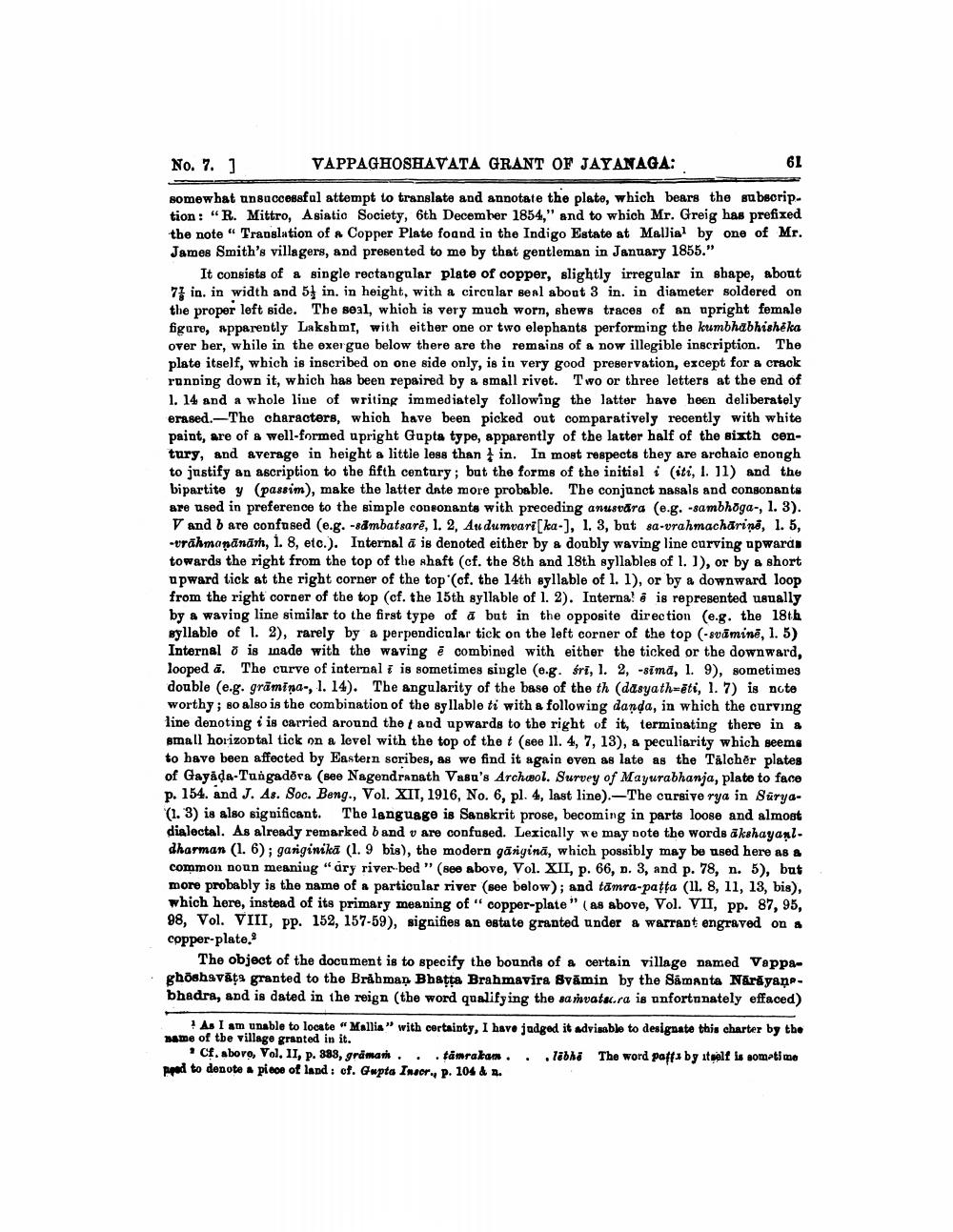________________
No. 7. ] VAPPAGHOSHAVATA GRANT OF JAYANAGA: somewhat unsuccessful attempt to translate and annotate the plate, which bears the subscription: "R. Mittro, Asiatic Society, 6th December 1854," and to which Mr. Greig has prefixed the note" Translation of a Copper Plate foand in the Indigo Estate at Mallial by one of Mr. James Smith's villagers, and presented to me by that gentleman in January 1855."
It consists of a single rectangular plate of copper, slightly irregular in shape, about 71 in. in width and 54 in. in height, with a circular seal about 3 in. in diameter soldered on the proper left side. The seal, which is very much worn, shews traces of an upright female figure, apparently Lakshmi, with either one or two elephants performing the kumbhabhishēka over ber, while in the exergue below there are the remains of a now illegible inscription. The plate itself, which is inscribed on one side only, is in very good preservation, except for a crack ronding down it, which has been repaired by a small rivet. Two or three letters at the end of 1. 14 and a whole line of writing immediately following the latter have been deliberately erased. The characters, which have been picked out comparatively recently with white paint, are of a well-formed upright Gupta type, apparently of the latter half of the sixth century, and average in height a little less than in. In most respects they are archaic enongh to justify an ascription to the fifth century; but the forms of the initial i (iti, I. 11) and the bipartite y (passim), make the latter date more probable. The conjunct nasals and consonants are used in preference to the simple consonants with preceding anusvára (e.g. -sambhoga-, 1. 3).
V and b are confused (e.g. -8àmbatsarē, 1. 2, Audumvari[ka-], 1.3, but sa-vrahmacharini, 1. 5, -urāhmanānām, 1. 8, etc.). Internal ā is denoted either by a doubly waving line curving upwards towards the right from the top of the shaft (cf. the 8th and 18th syllables of 1. 1), or by a short a pward tick at the right corner of the top of the 14th syllable of 1. 1), or by a downward loop from the right corner of the top (cf. the 15th syllable of l. 2). Internal is represented usually by a waving line similar to the first type of a but in the opposite direction (e.g. the 18th syllable of 1. 2), rarely by a perpendicular tick on the left corner of the top (-svā minē, 1. 5) Internal o is inade with the waving ¿ combined with either the ticked or the downward, looped a. The curve of internal i is sometimes single (e.g. fri, l. 2, -simd, 1. 9), sometimes double (e.g. grāmina., 1. 14). The angularity of the base of the th (dasyath=ēti, 1. 7) is acte worthy; so also is the combination of the syllable ti with a following danda, in which the curving line denoting i is carried around the / and upwards to the right of it, terminating there in a small horizontal tick on a level with the top of the t (see 11. 4, 7, 13), & peculiarity which seems to bave been affected by Eastern scribes, as we find it again even as late as the Tälcher plates of Gayada-Tungadora (see Nagendranath Valu's Archwol. Survey of Mayurabhanja, plate to face p. 154. and J. As. Soc. Beng., Vol. XII, 1916, No. 6, pl. 4, last line).-The cursive rya in Sürya(1.3) is also significant. The language is Sanskrit prose, becoming in parts loose and almost dialectal. As already remarked band v are confused. Lexically we may note the words akshayanl. dharman (1. 6); gariginikā (1. 9 bis), the modern gäriginā, which possibly may be used here as a common noun meaning "dry river bed" (see above, Vol. XII, p. 66, n. 3, and p. 78, n. 5), but more probably is the name of a particular river (see below); and tämra-patta (11. 8, 11, 13, bis), which here, instead of its primary meaning of " copper-plate" (as above, Vol. VII, pp. 87, 95, 98, Vol. VIII, pp. 152, 157-59), signifies an estate granted under a warrant engraved on a copper-plate.
The object of the document is to specify the bounds of a certain village named Vappaghoshavăța granted to the Bråhman Bhatta Brahmavira Svāmin by the Samanta Nārāyan - bhadra, and is dated in the reign (the word qualifying the samvatara is unfortunately effaced)
! As I am unable to locate "Mallia" with certainty, I have judged it advisable to designate this charter by the name of the village granted in it.
. Cf. aboro, Vol. II, p. 883, gräman...tämrakan. Tabhi The word paffa by itself is sometimo Reed to donote a piece of land : of. Gupta Inscr.. p. 104 & 2.




